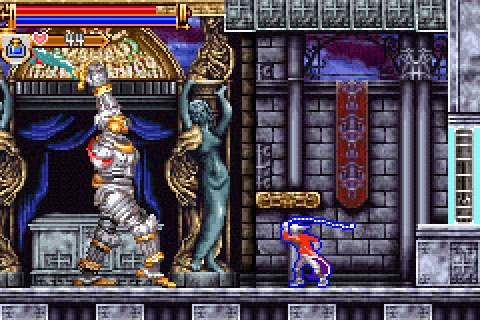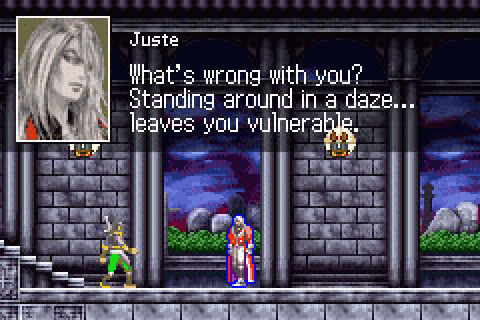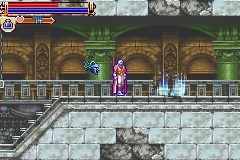 |
Castlevania: Harmony of Dissonance - Review |
 |
Dissonance Comes Close
By: Andrew Long
| Review Breakdown |
| Battle System |
4 |
| Interface |
6 |
| Music/Sound |
7 |
| Originality |
3 |
| Plot |
3 |
| Localization |
5 |
| Replay Value |
8 |
| Visuals |
7 |
| Difficulty |
Easy |
| Time to Complete |
5-10 hours
|
|
| Overall |
 |
| Criteria
|

|
| |
Castlevania has always been all about formula; that every game involves essentially the same plotline - find Dracula's castle, find Dracula, engage Dracula in some of the lousiest dialogue possible, banish Dracula to another dimension until Konami needs some more pocket money - is probably the most obvious indication of this particular pattern. Thus, it is not surprising that Castlevania: Harmony of Dissonance fits right into that design. It seems clear that in most respects, Konami has endeavoured to model this Game Boy Advance title as closely as possible after what is possibly its most successful entry in the series, Symphony of the Night. Unfortunately, somewhere along the way, it seems to have forgotten what made SotN so entertaining. While Harmony of Dissonance is enjoyable at times, it is also mysteriously flawed in many other respects. Ultimately, these shortcomings hamper the overall quality of the game to the point where it can become very tedious to play at times. Tedium, needless to say, is not a good selling point.
Like any Castlevania, HoD begins with an oddly androgynous vampire hunter streaking into the depths of Dracula's eminently spooky castle by moonlight. The bishy hero of the day in this outing is Juste Belmont, a suitably pouty fellow whose friends Maxim and Lydie have stumbled onto something dark and mysterious in the famous castle. On the downside, mysterious generally means "mind controlling and evil" in the context of Castlevania, so soon Juste is in a race against both time and his friend as the resurrection of Dracula becomes a greater and greater threat.
Fortunately, Juste is no pushover when it comes to the deadly arts of whipsmanship and throwing stuff that falls out of candles, and so he is able to push, stab, and blow his way up through the castle. Combat in Harmony of Dissonance is classic Castlevania; Juste can swing his whip and learn a number of useful techniques to aid him in his destructive ways. That number, unfortunately, is not terribly high; while there is a magic system implemented through the use of the various sub-weapons that fall from candles, it is to a large extent redundant, since resistance to various sorts of magic tends not to make very much difference in how much damage these spells do. Moreover, any sneaky moves Juste does learn with his whip are nullified by the pitifully low damage they do, and when it becomes necessary to fit various accessories on to the whip to do added damage or perform special tricks like breaking various surfaces, it's more of a chore than a benefit. Add to this the fact that defeating most bosses in the game is a simple matter of draining one's magic and then hammering mindlessly on them with the whip, and the battle system's appeal decreases rapidly.
At least Konami put some thought into the interface. Switching between magic is made easier through the use of hotkeys, and equipment is nicely streamlined. All is not perfect, however; switching between the actual spell groups themselves can require some truly heroic button mashing without actually using the menu, which draws into question the overall usefulness of this feature. An effort has, nonetheless, been made, and aside from some head-scratching item translations, there is little to complain about.

|
| Why 10:1 odds are sometimes a good bet
|
|
On another note, one can't help but wish that something would be done about the pitiful effort many companies put into the sound effects for Game Boy Advance titles. While the speaker output is certainly going to hamper the sound quality of most titles, there are other output devices available for the system, and it's a shame that more developers don't take a little more trouble to provide higher-quality sound samples. At the very least, the beeping and booping of eight-bit triangle and square waves should long since have taken their permanent place in the annals of video game history. These gripes aside, Konami has done a good job with what they've afforded themselves in the way of working materials. The music is compositionally sound, and the sound effects are reasonable, if slightly less than fantastic in the quality department. Castlevania titles have never disappointed in the music department, and with the composer for Symphony of the Night lurking around the fringes of the sound development for this game, it comes as little surprise that things turn out as well as they do.
Still, his involvement is just one more indication that Konami was hoping for a repeat of Symphony of the Night, not only in terms of success but in terms of all elements of the title. There are few pains taken to make the game seem fresh, and it does not feel that way at any point. This is not to say that it feels like an utter retread, but beyond mixing up a few staple elements and replacing a few with others that have not appeared in the series in a while, there is not much new offered here.
Like the plot. Aside from the occasional run-in with Maxim or Death, Juste's rollick through the depths of Castlevania is a solo effort, with precious little in the way of story to fuel his pursuit of Dracula. As with most action RPGs, the story is really not central to the game; however, the absence here is noticeable, and extends to the gameplay. While most action titles offer what seems to be open-ended exploration, Harmony of Dissonance often takes this to extremes. There tends to be no indication of where to go next, with items, both optional and those that allow progression, being scattered seemingly at random. While there's nothing wrong with non-linearity, this sort of game needs some sort of direction, or at least a logical progression. Else it risks feeling repetitive and pointless, and this is, unfortunately, precisely what happens at times.
The translation also comes across as occasionally redundant, if capably done. Item names in particular tend to come with humorously glib descriptions, such as Viking Helms "often worn by Vikings" , Medicine Jars that contain "medicine that makes you invincible at a set time", and Sun Armor "affected by the Sun". None of this terminology is precisely bad, but at the same time, these descriptions are hardly necessary or helpful. Add to that stilted dialogue (camp value not withstanding), and it is difficult to argue that this localization could not use some work. That said, it is certainly an adequate job.

|
| Juste takes a bite out of crime |
|
Then, too, what Harmony of Dissonance lacks in originality, it makes up for in its many different replay modes. Depending on how players beat the game, different replay options come up. From a "Boss Rush" mode that pits Juste against each of the game's bosses in rapid succession, to the ability to play through the game again as Maxim, there is a wealth of replay possibility to Harmony of Dissonance that goes a long way towards making up for some of the game's weaknesses.
Harmony of Dissonance also looks pretty good by Game Boy Advance standards. Konami is no stranger to two dimensions, and the work in this game is pretty much exemplary as far as sprite-based graphics go. In fact, the background art rivals that of its PlayStation cousin in many locations, and the interface art surpasses it. Character design is stereotypical Castlevania, but this is not a bad thing; a spooky castle is a spooky castle, and there's no need to jazz things up in this department.
Still, it might have been nicer if Harmony of Dissonance was a little harder, since it's pretty much the easiest game anywhere. Dying is never an issue, as most bosses just require some good old-fashioned button mashing. About the only problem gamers will ever have in completing the title is finding the various items, which can occasionally be a confounding process since there is no logical progression through the various areas of the castle. Still, warp rooms make getting from one area to another a breeze, so even this is not, in the end, enough to make HoD any more troublesome. It is not inconceivable to finish this game in under six hours, and it certainly shouldn't take any longer than ten.

|
| Medusa realizes she's late for Zelda 2: the Adventure of Link |
|
In the end, then, Harmony of Dissonance is nothing more than light gaming fare, and this is probably exactly what it's supposed to be. Appearing on a portable system as it does, there is little motivation for developers to make games any more complex than this right now, and until somebody steps up and does, Game Boy Advance titles will continue to be the Diet Soda equivalents of their console brethren. This has historically always been the case, so there is really no reason to consider Harmony of Dissonance anything other than a reasonably enjoyable game with a few flaws. On this basis, then, it's definitely worth a little look-see, if nothing more.
|










